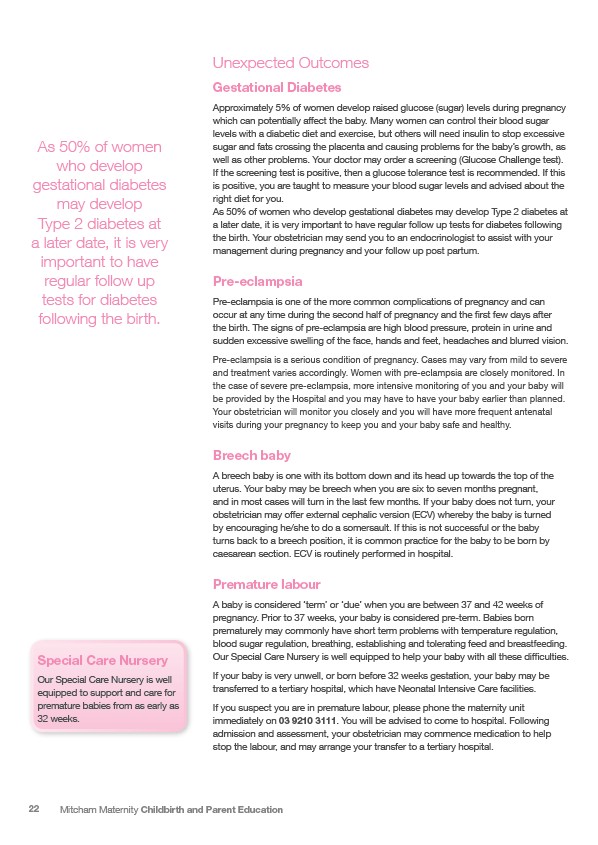
Unexpected Outcomes
Gestational Diabetes
Approximately 5% of women develop raised glucose (sugar) levels during pregnancy
which can potentially affect the baby. Many women can control their blood sugar
levels with a diabetic diet and exercise, but others will need insulin to stop excessive
sugar and fats crossing the placenta and causing problems for the baby’s growth, as
well as other problems. Your doctor may order a screening (Glucose Challenge test).
If the screening test is positive, then a glucose tolerance test is recommended. If this
is positive, you are taught to measure your blood sugar levels and advised about the
right diet for you.
As 50% of women who develop gestational diabetes may develop Type 2 diabetes at
a later date, it is very important to have regular follow up tests for diabetes following
the birth. Your obstetrician may send you to an endocrinologist to assist with your
management during pregnancy and your follow up post partum.
Pre-eclampsia
Pre-eclampsia is one of the more common complications of pregnancy and can
occur at any time during the second half of pregnancy and the first few days after
the birth. The signs of pre-eclampsia are high blood pressure, protein in urine and
sudden excessive swelling of the face, hands and feet, headaches and blurred vision.
Pre-eclampsia is a serious condition of pregnancy. Cases may vary from mild to severe
and treatment varies accordingly. Women with pre-eclampsia are closely monitored. In
the case of severe pre-eclampsia, more intensive monitoring of you and your baby will
be provided by the Hospital and you may have to have your baby earlier than planned.
Your obstetrician will monitor you closely and you will have more frequent antenatal
visits during your pregnancy to keep you and your baby safe and healthy.
Breech baby
A breech baby is one with its bottom down and its head up towards the top of the
uterus. Your baby may be breech when you are six to seven months pregnant,
and in most cases will turn in the last few months. If your baby does not turn, your
obstetrician may offer external cephalic version (ECV) whereby the baby is turned
by encouraging he/she to do a somersault. If this is not successful or the baby
turns back to a breech position, it is common practice for the baby to be born by
caesarean section. ECV is routinely performed in hospital.
Premature labour
A baby is considered ‘term’ or ‘due’ when you are between 37 and 42 weeks of
pregnancy. Prior to 37 weeks, your baby is considered pre-term. Babies born
prematurely may commonly have short term problems with temperature regulation,
blood sugar regulation, breathing, establishing and tolerating feed and breastfeeding.
Our Special Care Nursery is well equipped to help your baby with all these difficulties.
If your baby is very unwell, or born before 32 weeks gestation, your baby may be
transferred to a tertiary hospital, which have Neonatal Intensive Care facilities.
If you suspect you are in premature labour, please phone the maternity unit
immediately on 03 9210 3111. You will be advised to come to hospital. Following
admission and assessment, your obstetrician may commence medication to help
stop the labour, and may arrange your transfer to a tertiary hospital.
As 50% of women
who develop
gestational diabetes
may develop
Type 2 diabetes at
a later date, it is very
important to have
regular follow up
tests for diabetes
following the birth.
Special Care Nursery
Our Special Care Nursery is well
equipped to support and care for
premature babies from as early as
32 weeks.
22 Mitcham Maternity Childbirth and Parent Education